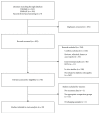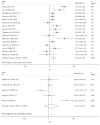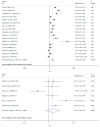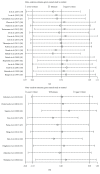Serum Vascular Endothelial Growth Factor Levels Correlate with Severity of Retinopathy in Diabetic Patients: A Systematic Review and Meta-Analysis
- PMID: 31019585
- PMCID: PMC6451802
- DOI: 10.1155/2019/9401628
Serum Vascular Endothelial Growth Factor Levels Correlate with Severity of Retinopathy in Diabetic Patients: A Systematic Review and Meta-Analysis
Abstract
Background: Investigations regarding serum and plasma vascular endothelial growth factor (VEGF) levels in patients with diabetic retinopathy (DR) are conflicting. This meta-analysis is aimed at determining whether serum and plasma VEGF levels are associated with DR and its severity in diabetic patients.
Methods: PubMed and EMBASE were used to search for published studies, and serum and plasma VEGF levels were compared among DR, nonproliferative diabetic retinopathy (NPDR), proliferative diabetic retinopathy (PDR), and nondiabetic retinopathy (NDR) patients. Standardized mean differences (SMD) and 95% confidence interval (CI) were pooled using a random effects model.
Results: A total of 29 studies comprising 1805 DR (or NPDR or PDR) patients and 1699 NDR patients were included. ELISA was used to evaluate serum or plasma VEGF levels in all except for two studies included in this meta-analysis. Overall, serum VEGF levels were significantly higher in DR patients (SMD: 0.74, 95% CI: 0.44-1.03) than those in NDR patients, while plasma VEGF levels were not in the comparison (SMD: 0.40, 95% CI: -0.13-0.92). Similarly, NPDR (SMD: 0.51, 95% CI: 0.22-0.80) and PDR (SMD: 1.32, 95% CI: 0.79-1.85) patients had higher serum VEGF levels compared with NDR patients, but the difference was not significant in plasma samples (SMD: 0.24, 95% CI: -0.47-0.95; SMD: 0.37, 95% CI: -0.30-1.05). In addition, serum VEGF levels were higher in PDR patients than those in NPDR patients (SMD: 0.87, 95% CI: 0.41-1.33), but plasma VEGF levels were not (SMD: -0.00, 95% CI: -0.31-0.31). The subgroup and metaregression analysis revealed that the study location, study design, and publication year of a study have certain influence on heterogeneity between studies in serum or plasma samples.
Conclusions: VEGF levels in the serum instead of those in the plasma correlate to the presence and severity of DR in diabetic patients. Further large-scale studies are required to confirm these findings.
Figures








Similar articles
-
Diagnostic and prognostic role of serum miR-20b, miR-17-3p, HOTAIR, and MALAT1 in diabetic retinopathy.IUBMB Life. 2019 Mar;71(3):310-320. doi: 10.1002/iub.1970. Epub 2018 Nov 23. IUBMB Life. 2019. PMID: 30468285
-
Vitreous and serum levels of vascular endothelial growth factor and platelet-derived growth factor and their correlation in patients with non-proliferative diabetic retinopathy and clinically significant macula oedema.Acta Ophthalmol. 2011 May;89(3):248-54. doi: 10.1111/j.1755-3768.2009.01661.x. Acta Ophthalmol. 2011. PMID: 19799585
-
[Changes of plasma endothelin-1 and vascular endothelial growth factor in diabetic retinopathy and the clinical application value thereof].Zhonghua Yi Xue Za Zhi. 2007 Oct 30;87(40):2837-9. Zhonghua Yi Xue Za Zhi. 2007. PMID: 18167288 Chinese.
-
Meta-analysis of the relationship between ocular and peripheral serum IL-17A and diabetic retinopathy.Front Endocrinol (Lausanne). 2024 Apr 22;15:1320632. doi: 10.3389/fendo.2024.1320632. eCollection 2024. Front Endocrinol (Lausanne). 2024. PMID: 38711982 Free PMC article.
-
Associations between Vascular Endothelial Growth Factor Gene Polymorphisms and Different Types of Diabetic Retinopathy Susceptibility: A Systematic Review and Meta-Analysis.J Diabetes Res. 2021 Jan 4;2021:7059139. doi: 10.1155/2021/7059139. eCollection 2021. J Diabetes Res. 2021. PMID: 33490285 Free PMC article.
Cited by
-
Serum and vitreous vascular endothelial growth factor levels in diabetic retinopathy.Int Ophthalmol. 2023 Jul;43(7):2247-2255. doi: 10.1007/s10792-022-02620-y. Epub 2022 Dec 29. Int Ophthalmol. 2023. PMID: 36580154
-
Genetics of Diabetic Retinopathy, a Leading Cause of Irreversible Blindness in the Industrialized World.Genes (Basel). 2021 Jul 31;12(8):1200. doi: 10.3390/genes12081200. Genes (Basel). 2021. PMID: 34440374 Free PMC article. Review.
-
Inflammatory and angiogenic biomarkers in diabetic retinopathy.Biochem Med (Zagreb). 2020 Oct 15;30(3):030502. doi: 10.11613/BM.2020.030502. Epub 2020 Aug 5. Biochem Med (Zagreb). 2020. PMID: 32774120 Free PMC article. Review.
-
Network Pharmacology and Molecular Docking to Explore the Mechanism of Compound Qilian Tablets in Treating Diabetic Retinopathy.Curr Comput Aided Drug Des. 2025;21(3):333-347. doi: 10.2174/0115734099298932240308104437. Curr Comput Aided Drug Des. 2025. PMID: 40420737 Free PMC article.
-
In vivo fluorescence molecular imaging of the vascular endothelial growth factor in rats with early diabetic retinopathy.Biomed Opt Express. 2021 Oct 29;12(11):7185-7198. doi: 10.1364/BOE.439446. eCollection 2021 Nov 1. Biomed Opt Express. 2021. PMID: 34858709 Free PMC article.
References
-
- Grigsby J., Betts B., Vidro-Kotchan E., Culbert R., Tsin A. A possible role of acrolein in diabetic retinopathy: involvement of a VEGF/TGFβ signaling pathway of the retinal pigment epithelium in hyperglycemia. Current Eye Research. 2012;37(11):1045–1053. doi: 10.3109/02713683.2012.713152. - DOI - PMC - PubMed
Publication types
MeSH terms
Substances
LinkOut - more resources
Full Text Sources
Medical

